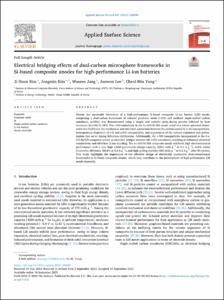Full metadata record
| DC Field | Value | Language |
|---|---|---|
| dc.contributor.author | Kim, Ji Hoon | - |
| dc.contributor.author | Kim, Jongmin | - |
| dc.contributor.author | Jang, Wooree | - |
| dc.contributor.author | Lee, Junwon | - |
| dc.contributor.author | Yang, Cheol-Min | - |
| dc.date.accessioned | 2024-01-03T23:10:15Z | - |
| dc.date.available | 2024-01-03T23:10:15Z | - |
| dc.date.created | 2023-10-25 | - |
| dc.date.issued | 2023-12 | - |
| dc.identifier.issn | 0169-4332 | - |
| dc.identifier.uri | http://hdl.handle.net/20.500.11750/47544 | - |
| dc.description.abstract | Herein, the successful fabrication of a high-performance Si-based composite Li-ion battery (LIB) anode, comprising a dual-carbon framework of reduced graphene oxide (r-GO) and oxidized single-walled carbon nanohorns (o-NHs), was demonstrated using a simple and scalable spray-drying process followed by heat treatment (h-s-GO/Si/NH). The r-GO nanosheets in the h-s-GO/Si/NH anode acted as a robust spherical framework that facilitated the mechanical and electrical connection between the carbon-coated Si (c-Si) nanoparticles, homogeneous dispersion of c-Si and o-NH nanoparticles, and suppression of the volume expansion and pulverization that occur during lithiation/delithiation. Additionally, the o-NH nanoparticles incorporated in the h-s-GO/Si/NH composite served as electrical bridges between the r-GO nanosheets, resulting in enhanced electrical conductivity and effortless Li-ion shuttling. The h-s-GO/Si/NH composite anode exhibited high electrochemical performance with a very high initial gravimetric charge capacity (2961 mAh g−1 at 0.1 A g−1), stable initial Coulombic efficiency (80.6% at 0.2 A g−1), and high cycling stability (983 mAh g−1 at 0.2 A g−1 after 50 cycles). This study highlights the importance of the effective design of electrically conductive three-dimensional frameworks in Si-based composite anodes, which may contribute to the development of high-performance LIB anode materials. © 2023 The Authors | - |
| dc.language | English | - |
| dc.publisher | Elsevier | - |
| dc.title | Electrical bridging effects of dual-carbon microsphere frameworks in Si-based composite anodes for high-performance Li-ion batteries | - |
| dc.type | Article | - |
| dc.identifier.doi | 10.1016/j.apsusc.2023.158494 | - |
| dc.identifier.wosid | 001086385000001 | - |
| dc.identifier.scopusid | 2-s2.0-85172673149 | - |
| dc.identifier.bibliographicCitation | Applied Surface Science, v.641 | - |
| dc.description.isOpenAccess | TRUE | - |
| dc.subject.keywordAuthor | Graphene oxide | - |
| dc.subject.keywordAuthor | Si | - |
| dc.subject.keywordAuthor | Single-walled carbon nanohorn | - |
| dc.subject.keywordAuthor | Li-ion battery | - |
| dc.subject.keywordAuthor | Anode materials | - |
| dc.subject.keywordPlus | COATED SILICON NANOPARTICLES | - |
| dc.subject.keywordPlus | LITHIUM | - |
| dc.subject.keywordPlus | GRAPHENE | - |
| dc.subject.keywordPlus | TEMPERATURE | - |
| dc.subject.keywordPlus | NANOTUBE | - |
| dc.citation.title | Applied Surface Science | - |
| dc.citation.volume | 641 | - |
| dc.description.journalRegisteredClass | scie | - |
| dc.description.journalRegisteredClass | scopus | - |
| dc.relation.journalResearchArea | Chemistry; Materials Science; Physics | - |
| dc.relation.journalWebOfScienceCategory | Chemistry, Physical; Materials Science, Coatings & Films; Physics, Applied; Physics, Condensed Matter | - |
| dc.type.docType | Article | - |
- Files in This Item:
-
 기타 데이터 / 7.07 MB / Adobe PDF
download
기타 데이터 / 7.07 MB / Adobe PDF
download
- Appears in Collections:
- Division of Energy Technology 1. Journal Articles



